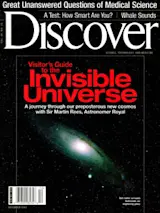Tim Flannery, director of the South Australian Museum in Adelaide, had never given much thought to dry dirt, but while he was researching “Lush Life,” an article on Australian flowers (page 78), he gained a new appreciation for aridity. “I discovered that some of the least fertile parts of our planet are home to its greatest biodiversity,” he says. Flannery is the author of several books, including The Eternal Frontier: An Ecological History of North America and Its Peoples.
Courtesy of Martin Mischkulnig
Martin Mischkulnig traveled thousands of miles to photograph the wildflowers of Australia (“Lush Life”). But the assignment wasn’t exactly foreign to him. Growing up outside Adelaide, he loved to career around the countryside on motorbikes with his sister. “We were unsupervised and would take off for two or three days at a time, exploring the sandhills and salt pans, everything desolate and dry.”
Martin Rees, Britain’s Astronomer ...














